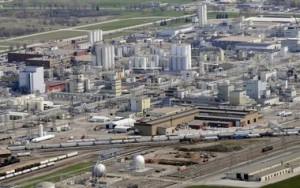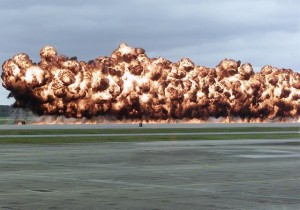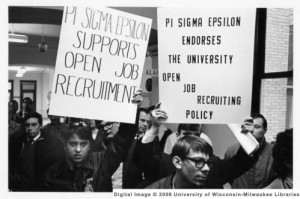
Placed alongside the Tittabawassee River, the Dow chemical plant stands defiant at the heart of Midland, Michigan. Today the chemical company is known for supplying many major companies with general factory and cleaning chemicals. Dow was founded in 1897 by Herbert Henry Dow, who invented an innovative bromine extracting technique, and used them in an innovative line of bromine based materials. The company began mainly selling bleach and basic cleaning products, and eventually found themselves diversifying and expanding around 1940 to help increase sales of their incredibly successful saran-wrap. Eventually Dow expanded to encompass a large percentage of Midland, employing many of the residents in various departments.
When the automotive and metalwork industries in the US began converting factories for the war effort, Dow chemical plant was given incentive to as well, eventually outputting as much as 90% of its product directly for the war. The products centered around magnesium, phenol, and bromine, for general necessities such as: explosives, flares, and medicine. These products helped make World War II a vastly different war.
The second World War was defined by the radical shift in technology: The bi-planes of the first World War were upgraded to mono-planes to minimize drag, the creation of personal light machine guns for combat effectiveness, computers, and chemical warfare. With the shocking introduction of widespread chemical warfare in World War I, the use of things like mustard agents and magnesium compounds found their way into the arsenals of armies across the globe. Weapons intended to level buildings and destroy fields were developed by scientists at Harvard University, notable outcomes being C-4 plastic explosives, and a chemical which was created by mixing aluminum soap powder with gasoline to imitate rubber, to make longer burning medium, this creation was called napalm B. The chemical saw its use in the later half of World War II, where it had been used by the allied forces extensively. One of the main tactics adopted by the allied forces, which take advantage of the coordinated plane strike capabilities, was to carpet bomb cities of cultural significance. This tactic saw firebombs (manufactured by DuPont and Dow) fall onto the German city of Dresden and the Japanese capital of Tokyo.

Napalm B’s affordability and effectiveness made it the perfect tool for the U.S. Military. These facts, coupled with the utility it provided in dense Vietnamese jungles, made it the ideal weapon to use as the staple of Vietnamese offensives. The napalm bombs were dropped on tactical installations to cripple North Vietnamese Army (N.V.A.) supply. Napalm had been an incredibly effective anti-personnel weapon due to the adhesive component that allowed longer burns, and eventually came to find the most use in snuffing out areas of jungle where troops were thought to be. This, coupled with Dow’s chemical defoliant agent orange, the U.S. apathetically, and indiscriminately attempted to burn the jungle down just to reach the North Vietnamese. The infamous “Girl in the Picture” was a result of the many of these indiscriminate bombings. The children in that picture are escaping the napalm strike that was mistakenly dropped on a village in Trang Bang outside of Saigon. Many strikes, like the one in Trang Bang, ended up hitting civilian targets. The reason being was that the N.V.A. began to plant anti-air installations near irrigation dykes, where the U.S. would refuse to attack. So the reduced accuracy of approved targets, consequently led to civilian targets being hit.
The Technology Of the Vietnam War
This rapid advance in technology and efficiency shaped the war like it had for any past war. Many of these new ideas, and efficiency proved to be deadly, on levels that were not anticipated. Napalm B had pushed the boundaries of morally sound weaponry. Its chemical components could be created out of essentially what is Styrofoam and gasoline. The lure of producing cheap chemical substances with that kind of power is hard to avoid. Likewise, the lure of using such chemicals is equivalently hard to avoid. With a new technology, and a new war at hand, the U.S. and the South Vietnamese forces used napalm with a wide variety of preexisting equipment. The so-called “Brown Water Navy” employed mounted napalm throwers, and the soldiers, with personal ones.
Although the conventional weapons of the decade had been argued to have kept the U.S. in the war a couple more years than it could have. The M-16, for example, was simply another evolution in the tools of war. So despite its effectiveness and utility, which was something to be feared during the campaigns in Vietnam, the weapon’s cultural impact was not nearly as far reaching. Pop culture references in movies like Apocalypse recognized the role that napalm had played.
What sets this weapon apart was both use and utility. The chemical’s original purpose, as a deforestation agent was lost rather quickly, as the military urgently needed a way to deal with the radical change in warfare. U.S. experience with modern war had been defined using familiar tactics as passed down by Jomini, and Clausewitz. Events such as World War II and the Korean War found the U.S. fighting directly: army-to-army. This idea of irregular warfare was a situation that the U.S. really had not prepared for. The guerrilla strategy from the N.V.A. led to the deaths of countless Americans. Napalm was employed as a brute-force counter to these tactics. Employed with the attitude that this was “just another weapon”, The U.S. dropped the equivalent of “approximately 250,000 pounds of napalm per day” from B-52 bombers. Yet the military was still not convinced that targets were being hit. Naturally this kind of indiscriminate fire would come to exasperate the Americans back on the home front. This weapon’s effect on troops was more than physical, it’s intention and effect had been mostly psychological. After evidence of the skin damage and toxins that napalm would cause, Vietnamese troops would fear jungle cover, as the U.S. had made it evident that they would use whatever means was necessary to eradicate the jungles and whatever cover the N.V.A. was rumored to be using. Chemicals in combat played a background role to allow an army to break a stalemate, in the case of WWI, or for shock value, in the case of WWII, but it wasn’t until Vietnam, that the role of these chemical weapons, along with agent orange – became a tactical device.
Vietnam on the Home Front
Domestically, this war had been different. Full color photographs and videos from war-journalists filled newspapers across the States. With how much was available to the public, it did not take long before protest groups began to come out and challenge the war. Photos like the above-mentioned “Girl in the Picture” became the face of war in Vietnam: unintelligent and brutal assaults, that would hit civilians. Despite how the war actually took place, the public was exposed to these images, and developed an emotional bias. The main target for these domestic uprisings: Dow Chemical Corporation. The company found themselves hindered by employee resignations and massive student demonstrations. The student body held peaceful sit-ins. as The napalm manufacturer had to halt job interviews on university campuses due to the student and faculty demonstrations, as described by the University of Wisconsin-Milwaukee:

Another series of demonstrations in California occurred, and were heightened by a transport error (Rawitch), when more than five tons of napalm bombs being transported from the Torrance Dow plant to Long Beach Harbor for shipment to Vietnam fell from a tractor. Dow’s response simply came as a dismissal, stating that their priorities were to the government above all, and that this was “business as usual”. This was the second “wave” of protests in California, the first came shortly after the public had become informed about the nature of napalm. Tensions rose during this second wave as the California college protests became violent in some instances. Between apathetic corporations and government secrets, the American public had realized that this war was going to be unlike anything the U.S. has participated in.
The LCM-8 Riverboat, or as it was known in Vietnam, the “Zippo”, appeared in numerous photos, which documented the use of napalm. Dow’s chemical creation utilized the polystyrene created from Styrofoam products acted as a thickening agent. This product was available in abundance as Dow had previously been a large producer of Styrofoam products. This thickening agent combined with petroleum created a fire that burned longer, and stuck to its target. A running cadence (marching song) sung during this time was entitled “Napalm sticks to kids” citing Dow Chemical, the inventor. As well as making implications about the ethics of the company. Many of the elements of the song cite the gruesome situations that the soldiers were placed in, frequently having to fire upon farmers, and sending napalm strikes against them. The references to various operations like PSYOPS (psychological operations) and the CIA implied that the soldiers were constantly in the dark, or frequently opposed to the war and all the secrets, themselves. Another such line reads:
Gather kids as you fly over town, By throwing candy on the ground, Then grease 'em when they gather 'round, Napalm sticks to kids.
This phrase indicates a lot of injustice occurring during the war, and implies how immoral this weapon had become. Potentially this also further strengthens the notion that the lines between enemy and ally had become blurred throughout the war. The inclusion of corporations by name seem to lead to the conclusion that the company backing of these wars was quite influential, and something that was frequently discussed between soldiers.
The rationale for Dow’s dismissal of protests can be traced back to World War II, where corporate support for the war was the norm, if not something that was expected. Industry fuels these wars and paved way for competition. And so this continuing attitude towards Vietnam as being like any other war fought previously, allowed Dow Chemical to power through criticism and continue to supply the war effort.
The effects that this weapon had had on the American public, as well as the Vietnamese on the receiving end of this unrestrained technology, proved that this new technology changed warfare in an unprecedented way. Dow Chemical became the poster child behind this movement, as the push for increased productions and performing “business as usual” was a philosophy that belongs in war on a much larger scale. Or a philosophy that belongs to a different era of military history. The strategies still had most of their roots in total war, relying on superior firepower to dominate the battlefield. When fighting a semi-organized single entity – conscription, and a war-time economy almost seem to be overcompensation. As the last times where these were used, were when the U.S. faced international threats and two-front wars. The domestic reaction was clear evidence that it was time for a change in how war was to be waged, and that there are standards of engagement that the military should follow. And that the importance of understanding the evolution of technology can allow intelligent strategy and planning. The outcome of the war, proves that with new technology, new tactics need to be devised, so that the new technology can be used responsibly and with good justification.
Primary Sources
[1] Unknown Composer. “Napalm Sticks to Kids”. by 1st of the 9th Cavalry, 1st Cavalry Division. 1970.
[2] UW-Milwaukee Photographs Collection. Students protesting against Dow Chemical, a major defense contractor. UWM AC 6. University of Wisconsin-Milwaukee Libraries, Archives Department.
[3] “Protest Ends Interviews by Napalm Maker.” Chicago Tribune 26 Oct. 1967: C4. Print.
[4] Rawitch, Bob. “‘Ultra-Lefts’ Make Plans.” Daily Breeze 8 May 1966. Print.
Secondary Sources
[5] “Torrance Plant Under Fire: Supporters, Foes of Napalm Present Their Arguments,” by Tony Shultz, Los Angeles Times, Dec. 10, 1967, Pg. CS1.
[6] Burke, Carol. “Marching to Vietnam.” The Journal of American Folklore: 424. Print.
[7] Kleber, Brooks E., and Dale Birdsell. “Origin of the Chemical Warfare Service.” The Chemical Warfare Service: Chemicals in Combat. Washington, D.C: Office of the Chief of Military History, United States Army, 1966. 4-34. Print.
[8] Taylor, Michael. “Military Says Goodbye to Napalm / Pentagon Recycles Remaining Stock of a Notorious Weapon.” SFGate. N.p., 4 Apr. 2001. Web. 11 Oct. 2015.
[9] Neer, Robert M. Napalm: An American Biography. Cambridge, MA: Belknap of Harvard UP, 2013. Print.
[10] “Military.” Napalm in War. Web. 18 Nov. 2015.
Further Readings
[12] “Historic Stock Footage Vietnam War.” Youtube.com.Buyout Footage Historic HD Film Archive.
[13] “The American Film Industry & Vietnam.” The American Film Industry & Vietnam. N.p., n.d. Web. 18 Nov. 2015.
[14] “Two Days in October.” PBS. PBS, 22 Sept. 2005. Web. 11 Oct 2015.
